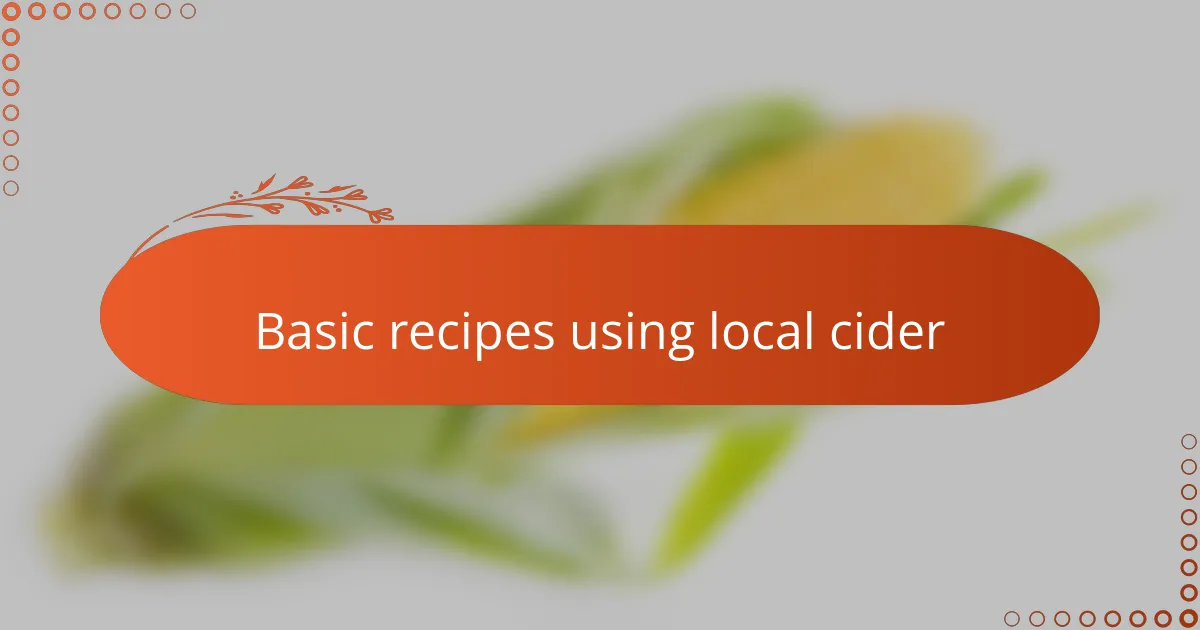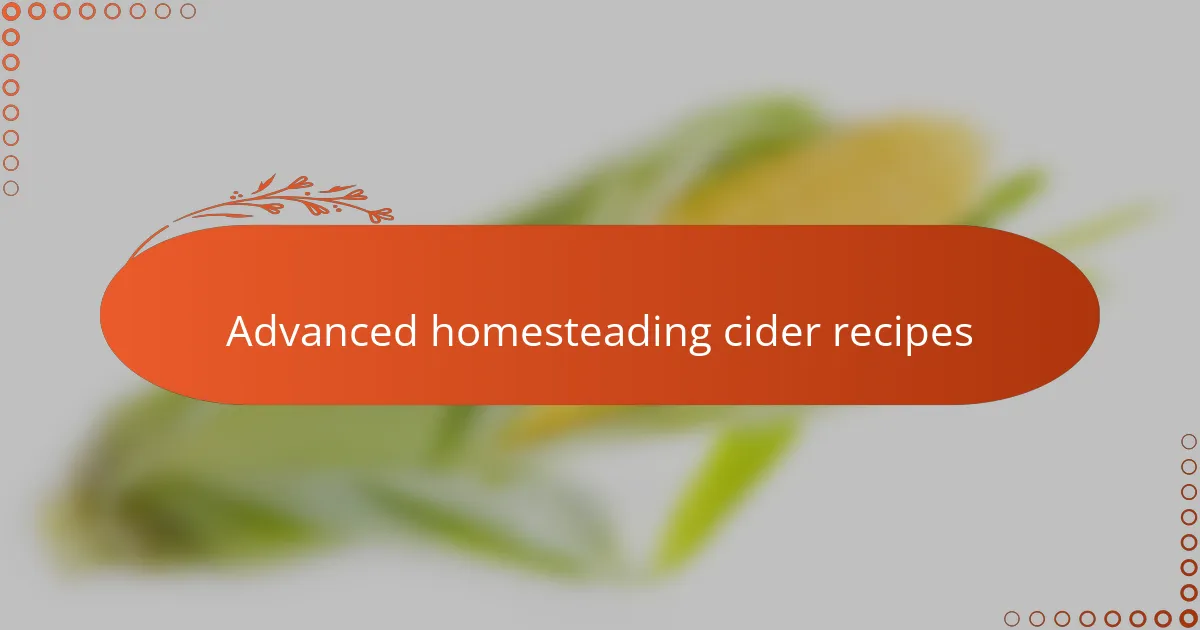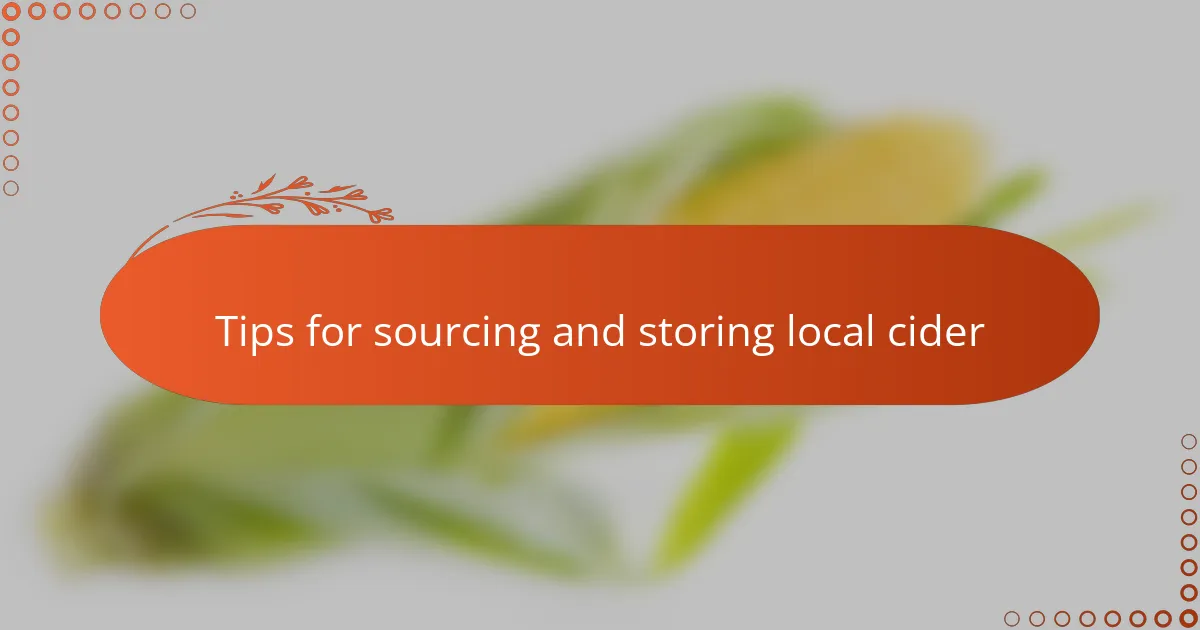Key takeaways
- Local cider enhances cooking by adding depth of flavor and supporting local farmers, promoting community sustainability.
- Essential tools for using cider include sturdy saucepans, fine mesh strainers, and precise measuring cups for optimal results in recipes.
- Simple recipes like cider-braised chicken and poached fruits showcase the versatility of local cider in both savory and sweet dishes.
- Proper sourcing and storage of local cider through farmers’ markets maintain freshness and preserve its vibrant taste.

Introduction to local cider
Local cider, to me, is more than just a drink—it’s a snapshot of place and season, captured in a bottle. I remember the first time I sipped cider made from apples grown just down the road; the flavors were vibrant and somehow felt more authentic than anything store-bought. Have you ever wondered how the soil, climate, and care poured into those apples can shape the taste of cider?
When I think about local cider, I think about connection—connecting with farmers, with nature, and with tradition. This connection transforms the simple act of drinking cider into a meaningful experience that celebrates the land right outside my door. Isn’t it amazing how something so seemingly ordinary can tell such a rich story?
What fascinates me most is how local cider varies from one region to another. Each batch carries its own personality, influenced by varieties of apples and techniques unique to its origin. This diversity invites me to explore and experiment in my kitchen, enhancing my homesteading journey in unexpected ways.

Benefits of using local cider in cooking
One of the biggest benefits I’ve found using local cider in my cooking is the depth of flavor it brings. Unlike generic cider or vinegar, local cider carries the essence of its orchard—sometimes sweet, sometimes tart—and that complexity makes sauces and marinades come alive. Have you ever noticed how a dish simply glows when it’s made with ingredients full of character?
I also appreciate how local cider supports my community and small farmers. When I cook with it, I feel like I’m part of something bigger, something sustainable. It’s not just about taste but about honoring the land and the people who tend it, which adds a whole new layer of meaning to my meals.
Cooking with local cider has taught me to embrace seasonality more deeply. Each batch reflects the harvest’s quirks, so every dish carries a little surprise. Isn’t it wonderful that a simple bottle can turn routine cooking into a celebration of place and time?

Essential tools for cooking with cider
When I cook with local cider, having the right tools makes all the difference. A good, sturdy saucepan helps me gently reduce cider into a rich glaze without burning off the delicate flavors—a small but crucial detail I learned the hard way. Have you ever noticed how easily cider can go from perfectly caramelized to bitter if the heat is too high?
A fine mesh strainer is another essential in my kitchen. It catches any sediment or bits from the cider that might cloud sauces or dressings, giving everything a smooth, refined finish. I find that this little step elevates the dish, making it feel more polished without much extra effort.
Of course, measuring cups and spoons are indispensable, especially when balancing cider’s natural sweetness and acidity. Getting that harmony right takes practice, but with precise measurements, I can recreate my favorite recipes again and again. Don’t you love it when a recipe turns out just as you remember it?

Basic recipes using local cider
Using local cider in basic recipes has become a delightful staple in my kitchen. One of my favorites is a simple cider-braised chicken, where the cider’s subtle sweetness and acidity break down the meat, making it tender and flavorful without much fuss. Have you ever noticed how something as straightforward as swapping water or broth for cider can transform a dish entirely?
Another go-to for me involves making a quick pan sauce by deglazing with local cider after sautéing vegetables or meat. The cider picks up those browned bits, adding a bright, tangy note that lifts the whole meal. It’s such an easy trick, but it never fails to impress guests or family gathered around the table.
For desserts, I often turn to cider as a poaching liquid for fruits like pears or apples. It gently infuses the fruit with orchard freshness while softening it to perfection. Sometimes, I wonder why more cooks don’t use cider this way—it feels like such a natural pairing that brings out the season’s best.

Advanced homesteading cider recipes
When I started experimenting with advanced homesteading cider recipes, I discovered that reducing local cider slowly not only intensifies its flavor but creates a luxuriously sticky glaze perfect for roasting pork or drizzling over roasted root vegetables. Have you ever tasted something so simple yet so packed with layers of sweetness and tartness that it elevates an entire meal?
One of my favorite techniques is fermenting cider with added spices and herbs to craft unique shrubs or drinking vinegars. The process requires patience, but the complex, tangy elixirs that emerge are endlessly rewarding and great for both cocktails and salad dressings. Don’t you enjoy how a small fermentation project can transform your kitchen into a playground of flavour experimentation?
Another method I adore involves incorporating local cider into slow-braised dishes, allowing its natural acidity to tenderize tough cuts while imparting orchard-inspired notes. This technique taught me how embracing the character of local ingredients elevates simple homestead cooking into something truly memorable. Have you ever found that one ingredient that becomes your secret weapon in the kitchen? For me, that’s always been local cider.

Tips for sourcing and storing local cider
Finding local cider at farmers’ markets or directly from orchards has always been my favorite way to ensure freshness and authentic flavor. I’ve noticed that chatting with the growers often leads to discovering lesser-known varieties or special batches that aren’t available in stores. Have you tried asking about their harvest methods? It adds a layer of appreciation to every sip.
Once I bring cider home, storing it properly is key to preserving its vibrant taste. I keep my cider in a cool, dark place, like the basement or a pantry corner, to slow down any unwanted fermentation. Over time, I found that a tightly sealed bottle helps maintain the cider’s crispness much longer—don’t you hate when that fresh sharpness dulls too soon?
On a practical note, if I’m not planning to use the cider right away, refrigerating it is my go-to method. Cold temperatures keep the cider fresh for several weeks and prevent it from turning overly fizzy or sour. Have you ever opened a bottle only to find it gone flat or unexpectedly tangy? Proper storage really saves the day in those moments.

Personal experiences with local cider cooking
I recall the first time I used local cider in a pork roast—it was transformative. The cider’s sweetness lent a subtle complexity that made the dish sing, and I couldn’t help but smile as my family eagerly dug in. Isn’t it something special when a simple ingredient brings that much joy to the dinner table?
One experiment that sticks with me is adding local cider to my homemade pancake batter. The slight tang from the cider created a delicate fluffiness and a flavor twist that surprised even me. Have you ever stumbled on a substitute that turned an everyday recipe into a memorable treat?
Sometimes, I just splash local cider into a warm skillet with butter and herbs to baste chicken breasts. The aroma alone makes the kitchen feel cozy, and the finished dish always has that perfect balance of savory and sweet. Doesn’t cooking become more rewarding when the smells draw everyone closer?



